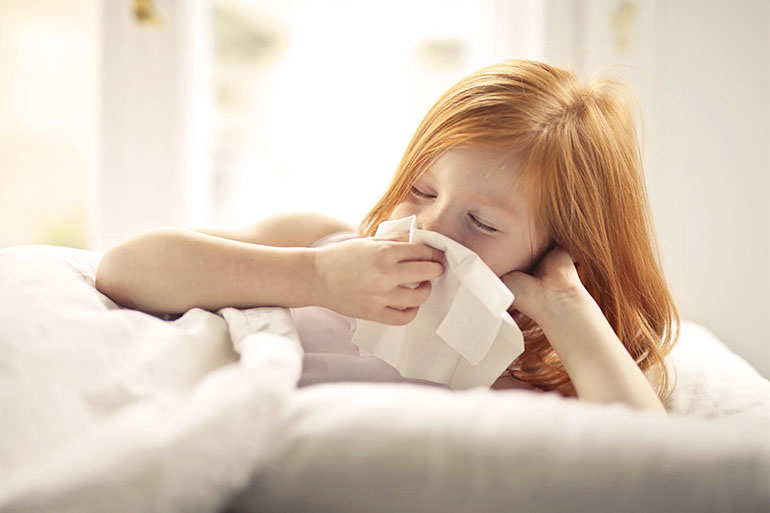December 1, 2022
November 15, 2022
It’s perfectly normal for a child to pick up germs and mild illnesses at school. As the teachers at our local daycare say, the children have a runny nose from September when the school year starts, all the way through June when the school year ends. Colds and flus in children are almost unavoidable, but in most cases perfectly treatable. Let’s discuss the most common diseases in children, the signs and symptoms, and when it’s time to go to the doctor or hospital.

10 Most Common Diseases in Children
According to the National Health Service (NHS), these illnesses and diseases are the most common among children:
1. Common Cold: Colds are caused by viruses in the upper respiratory tract, and spread through close contacts with others. They are marked by the sniffles, a runny nose, and sometimes fever, and symptoms can last for up to 10 days. A cold is generally treated at home with fluids and rest. Over-the-counter medicine can help treat colds in the case that your doctor think it necessary. Young children can get 6 to 8 colds per year.
2. Flu: A big step up from the common cold, the flu is a virus spread through coughing or sneezing. Symptoms include fever, body aches, chills, and fatigue. It is generally treated at home with medication, fluids, and rest, but if symptoms turn severe, you need to go to the doctor or hospital immediately. Reduce the risk and severity of the disease by getting the flu vaccine in Spain.
3. Ear Infection: Caused by bacteria or viral infection, ear infections are more common in kids than adults. The most common symptom is ear pain, and a sign that your child may have an ear infection is them tugging at their ear. Most ear infections do not require antibiotics, and can be treated with drops. However, if it is severe, amoxicillin is the preferred antibiotic prescribed for ear infections (unless there is an allergy or recurring infection).
4. Pink Eye: Conjunctivitis is called pink eye because “pink eyes” are it’s discerning factors. The primary symptoms include swelling, redness, itching, or discharge around one or both eyes. Conjunctivitis is caused by bacteria that gets into the eye and is treated by eye drops or antibiotic cream prescribed by a doctor. When your child has pink eye, avoid contact with other children and tough the face as little as possible so as to not spread the bacteria to others.
5. Sinus infection: This is a build-up of fluid around the sinuses due to viruses. The signs are a runny, stuffy nose, headache, facial pressure, mucus in the throat, and a cough. A sinus infection can be especially annoying for breastfeeding babies and young children as they have difficulty breathing through their nose. A sinus infection usually goes away own its own after a few days, but a pharmacist can recommend safe decongestant nasal sprays or drops for children.
6. Stomach flu: Gastroenteritis is the stomach flu, and it is caused by a quickly spreading virus, with typical symptoms being nausea, vomiting and diarrhea. In Spain, you can choose to get your children vaccinated for it during their baby vaccination schedule, although it does not reduce the risk entirely. Rest and replenishing fluids is vital when your child has gastroenteritis, due to actively losing nutrients via vomiting and diarrhea.
7. Bronchitis: This usually occurs after an upper respiratory infection, when mucus gets into the lungs. Symptoms include coughing, sore chest, fatigue, headache, body ache, and sore throat. Rest, fluids, and pain relievers can help. But if there’s fever, coughing up blood, or symptoms last longer than 3 weeks, you should go to the pediatrician to check if it could be pneumonia. In that case, they will perform a chest X-ray or mucus sample.
8. Strep Throat: Caused by bacteria that gets into the nose and throat, and spread through coughs, sneezes, and infected items (like toys). Signs of strep throat are sore throat, fever, swollen tonsils, and stomach pain. This illness must be treated with antibiotics prescribed from a doctor after a strep test. A lab test or in-office rapid strep test, which includes a quick swab of the throat, is necessary to confirm the diagnosis of strep. If positive for strep, your pediatrician will prescribe an antibiotic.
9. Hand, foot, and mouth (HFM) disease: This is a very contagious disease, most often seen in children under 5 years old. Symptoms include skin-rash, fever, mouth sores, and flu-like symptoms. You cannot treat this with antibiotics, although mouth pain can be relieved through gels, sprays or mouthwashes that a pharmacist can recommend. After plenty of rest, fluid, and avoiding hot/spicy foods that may cause mouth pain, HFM disease usually goes away within 7-10 days.
10. Chickenpox: Chickenpox is highly contagious, which is why when there’s an outbreak of chickenpox in the classroom or in a friend group, everyone needs to isolate immediately. The most common symptom is an itchy red rash or spots that cover the whole body. It is essential not to scratch too much so as to not cause scarring. Most kids recover from resting, but severe cases may require prescription medication.
When to go to the doctor or hospital
Rest, fluids, and over-the-counter medication sometimes only go so far. If your child has prolonged or extremely severe symptoms, it may be time to seek medical advice. Here’s how you know:
- Symptoms lasting several weeks, with no improvement in condition.
- High fever, difficulty breathing, or dehydration.
- Disoriented or confused.
- Constant crying, or a cry other than their normal cry.
- Has another chronic illness, weak immune system, diabetes, asthma, etc.
If you have any questions or queries, please contact your doctor. Remember that this is purely an informational blog. For peace of mind and being able to consult a doctor for your child whenever you need them, discover Caser Expat Insurance’s family healthcare plans.
|
If you are searching for health insurance in Spain, Caser Expat Insurance has the right policy for you!
|
.png?width=344&height=67&name=logo_caser%20(2).png)









Let Us Know What You Thought about this Post.
Put your Comment Below.